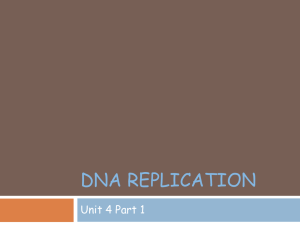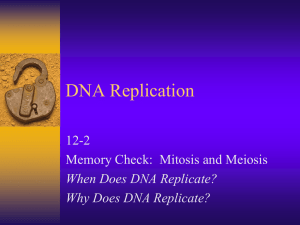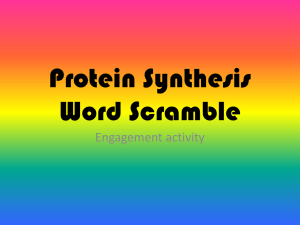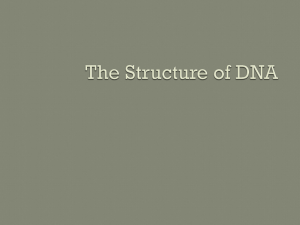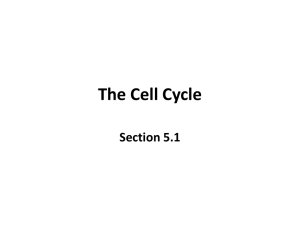DNA replication
advertisement
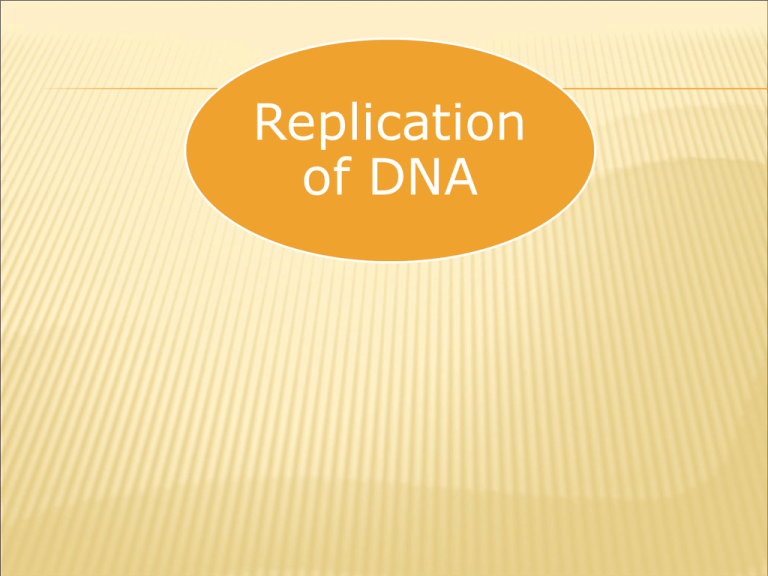
Replication of DNA The process of making a copy of DNA is called DNA REPLICATION. Why does DNA need to be copied??? DNA contains all the information required for the function of a cell and the organisms. Remember the base pair rule: A always pairs with T G always pairs with C This pairing allows DNA to act as a template (a guide or pattern) for its own replication. SUMMARY OF DNA REPLICATION Do not copy DNA replication occurs in 4 stages: 1. “Unzipping” of DNA helix 2. Priming of DNA 3. Addition of nucleotides to the exposed nitrogen bases. 4. Proofreading ENZYMES play a major role in DNA replication 1. “UNZIPPING” OF DNA STRANDS DNA replication occurs during the synthesis (S) phase of the cell cycle, before a cell divides. a)The double helix unwinds with the help of DNA HELICASES. These enzymes break the hydrogen bonds between the base pairs. b. Once the two strands are separated, additional proteins hold them apart preventing them from rewinding. The areas where the double helix separates are called replication forks because of their Y shape. 2. PRIMING OF DNA The exposed bases have to be “primed” (prepared) to accept new nucleotides. This is done with the help of PRIMASE: short molecules called primers attach to the exposed bases and serve as a starting point for DNA synthesis. 3. ADDITION OF NUCLEOTIDES Once the helix is unwound and primed an enzyme called DNA POLYMERASE moves along each strand of DNA adding free-floating nucleotides to the exposed bases, according to the basepairing rules. HOWEVER NOTHING IS AS SIMPLE AS IT SEEMS!! Remember the numbering of the sugar molecules in DNA: One strand of nucleotides will be pointing with the 5’ end at the top while the other strand will be going in the opposite direction. 3’ 2’ P C 4’ 5’ O Nitrogen Base C 3’ C C C 2’ C 1’ C 1’ Nitrogen Base 4’ O 5’ C P ADDITION OF NUCLEOTIDES CONT. DNA polymerase can only synthesize a new strand of DNA in a 5’ 3’ direction. Since replication can only proceed from a 3’ to the 5’ direction of the original molecule, on the contiguous (LEADING) strand, nucleotides are inserted in a smooth continuous manner. The strand that is oriented in the 3’ to 5’ direction is known as the lagging strand because nucleotides are added in small segments called “Okazaki” fragments. These fragments are eventually joined by an enzyme called “ligase” into one long strand. DO NOT COPY The human DNA is up to 80 million base pairs long. As a result DNA is”unzipped” at multiple places along its length and DNA replication steps are carried out simultaneously at many places. Fact File: The human DNA is copied at about 50 base pairs per second. The multiple location of DNA replication process takes about 1 hour to complete. If this were not the case, then it would take about a month to finish replicating the entire DNA strand! 4. PROOFREADING DNA replication is not complete until several enzymes including DNA polymerase have proofread the nucleotides being added to the strand. If they are not found to be complementary they are removed and the correct ones are added. DNA replication is considered “semiconservative” since ½ of the original strand is preserved in each new double helix. Step Name 1. Unzipping 2. Priming 3. Adding nucleotides 4. Proofreading Enzyme(s) Used Process DNA helicase Helicase unwinds DNA at replication forks by breaking hydrogen bonds between bases. DNA primase Primase adds short segments of bases (5-10) to 5’ ends of new strand. DNA polymerase DNA ligase DNA polymerase Other enzymes Polymerase adds bases to 5’ ends of new strand. Outside strand called leading strand. Inside strand called lagging strand. Lagging strand forces polymerase to work “upsidedown” making it fall off at many points. Forms Okazaki fragments. Ligase adds bases to join Okazaki fragments. Polymerase and other enzymes make sure correct bases are added. If incorrect, removes them and adds correct ones.
